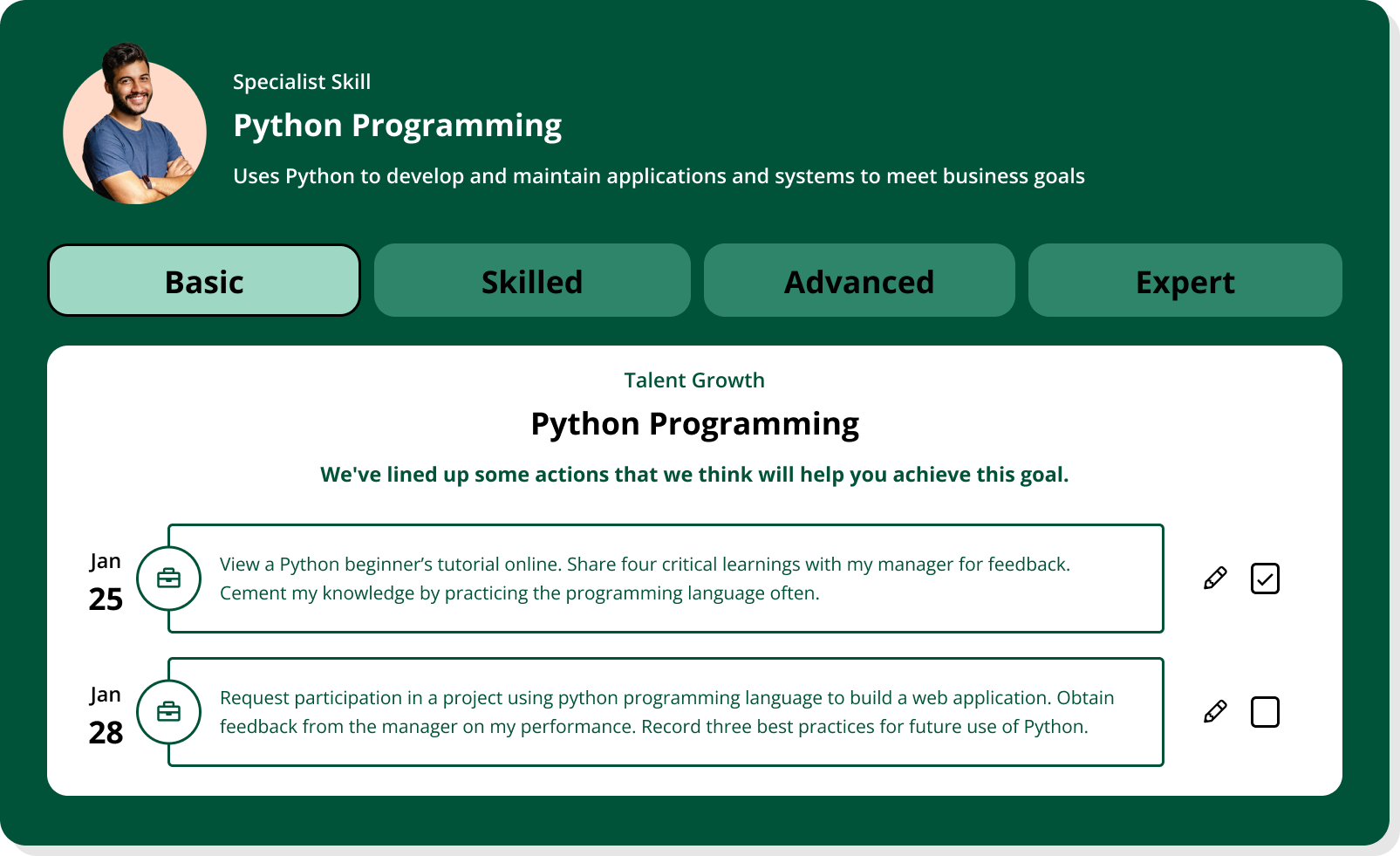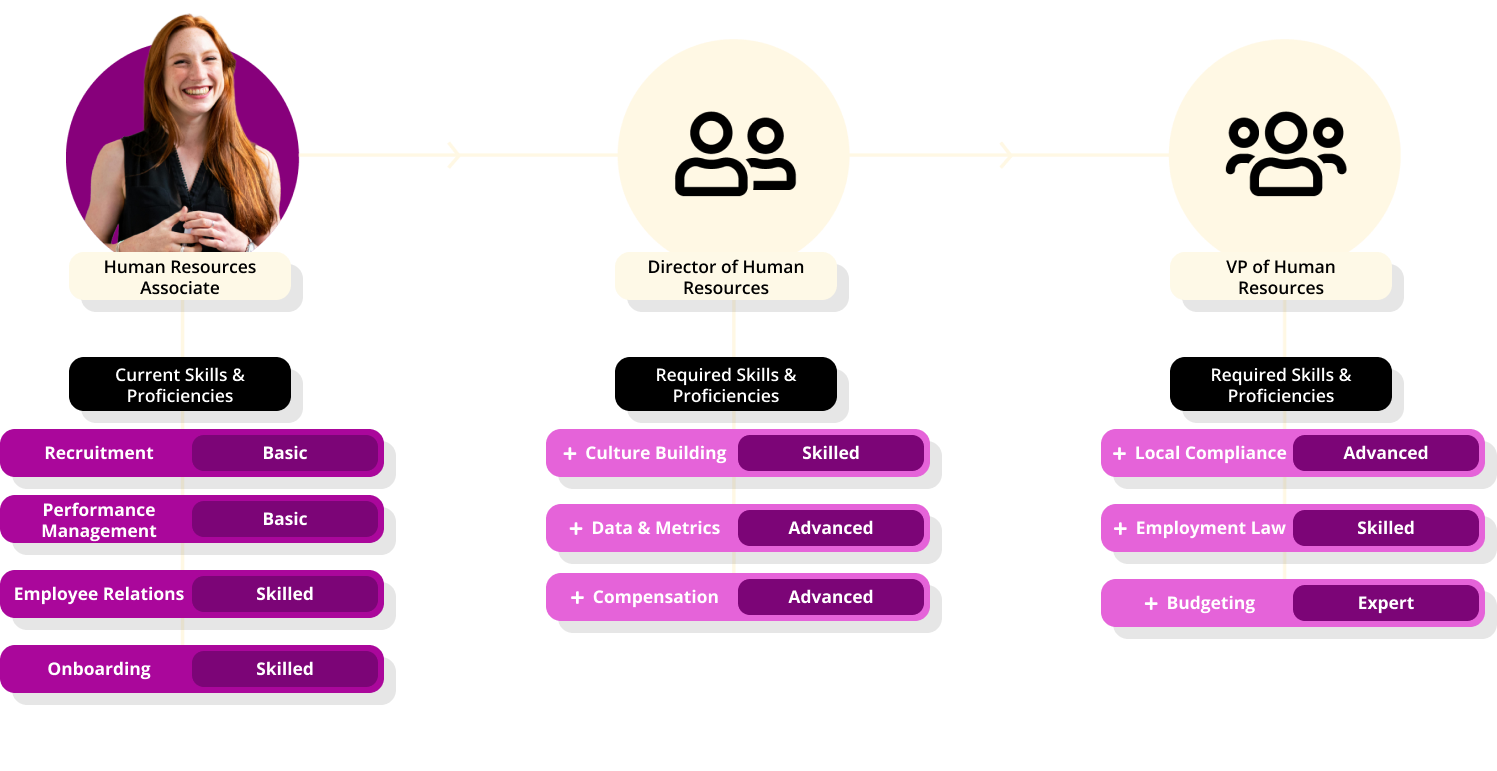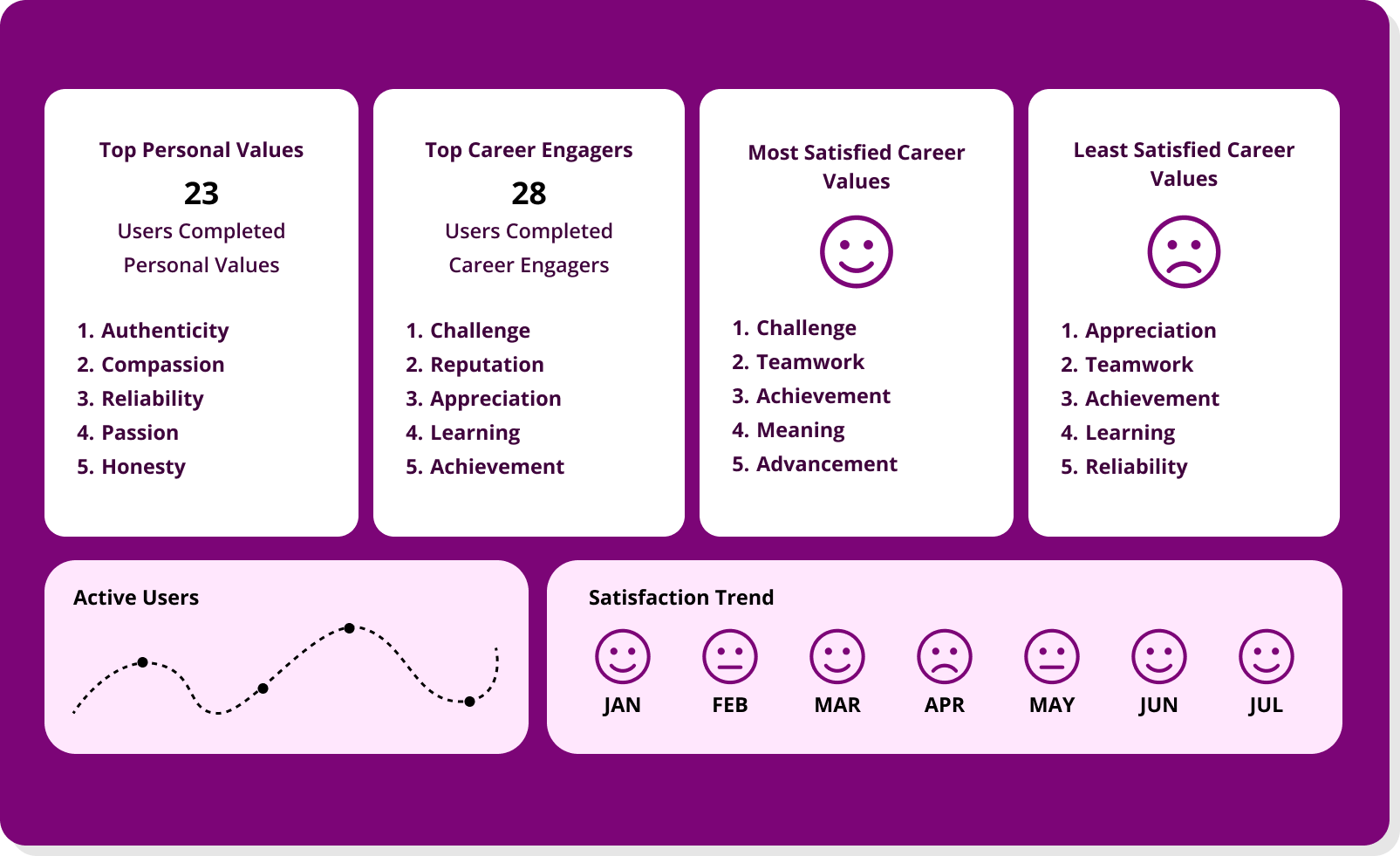When an engineering manager at a growing tech company needs a senior developer, they typically open a job requisition, write requirements like “5+ years of Python experience” and “strong team leadership skills,” then hope HR finds someone who matches.
Meanwhile, three floors down, a talented developer in another department has been building side projects in Python for years and mentoring junior developers, but neither the manager nor HR knows they exist.
That’s where skills architecture comes in.
A skills architecture is the underlying structural framework that maps, connects, and evolves the complete landscape of skills within an organization.
Unlike traditional skills frameworks that simply list required competencies, a skills architecture creates a dynamic, interconnected system that shows how skills relate to roles, each other, and business objectives.
It transforms scattered skills data into actionable intelligence that powers everything from hiring to development and workforce planning.
In this article, we’ll examine:
- How skills architecture differs from traditional competency frameworks
- The key components of an effective structure
- Common pitfalls organizations face in implementation
- How to leverage skills architecture to drive tangible business value
How does skills architecture differ from a basic skills framework?
Most organizations believe they have a handle on skills management because they maintain spreadsheets of competencies or use HR software with built-in skills libraries. But these basic frameworks are fundamentally static. They capture point-in-time requirements, usually in the form of bulleted lists attached to job descriptions.
These frameworks typically emerge from annual job analysis exercises or industry-standard templates. While they do serve a documentation purpose, they fail to convey how skills flow and evolve within an organization.
In contrast, skills architecture, integrated with a structured job architecture, creates a dynamic intelligence layer. Instead of simply stating that a software architect needs cloud computing skills, it displays how that skill connects to related capabilities like distributed systems design, maps its relationships to business outcomes like system scalability, and shows progression paths from cloud basics to expert-level architectural patterns.
In essence, a basic framework tells you what skills you have, while a skills architecture tells you what they mean, how to develop them, and where they’re taking you.
The following key elements distinguish this complex structure from its simpler counterpart.
Relationships over lists
Where basic frameworks present flat lists, skills architecture establishes meaningful links. It shows how skills build on each other, which ones frequently cluster together, and how they support both current and future organizational needs. This relational understanding is crucial for many business aspects, from career pathing to succession planning.
Intelligence over documentation
Beyond record requirements, a well-designed skills architecture synthesizes insights. It can identify emerging skill clusters, highlight critical gaps, and predict future needs based on business strategy. These in-depth revelations allow organizations to move from reactive hiring to proactive talent management and development.
Evolution over stasis
Perhaps most importantly, skills architecture is designed to evolve. It incorporates mechanisms for continuous validation and updating, whether through AI analysis of job market trends, internal use patterns, or regular expert review. This ensures the architecture remains relevant as essential skills rapidly emerge and transform.
The implications of these differences are profound. Although a basic framework can help you write job descriptions, a skills architecture enables talent mobility, targeted development, and strategic workforce planning.
This architectural approach is an asset with skills becoming more fluid. The half-life of technical skills continues to shrink, soft skills are gaining importance, and new hybrid roles emerge constantly. A static framework simply can’t keep up with this altering reality.
How to build and implement a robust skills architecture
Many companies get stuck in endless planning cycles or try to accomplish unfeasible goals. To construct top-notch skills architecture though, it’s best to start with foundational building blocks and then expand systematically.
The core skills data layer
Every skills architecture needs a well-established data layer. But, contrary to common practice, you don’t need an exhaustive skills catalog right away. Instead, you can begin with your most critical roles and functions. Map their core skills, proficiency levels, skills required, and basic relationships. This initial bedrock should be detailed enough to be useful but lean enough to maintain.
A critical mistake here is relying solely on HR or external consultants to build this layer. The most effective implementations combine:
- Industry skills frameworks for baseline structure
- Internal subject matter expert input for validation
- Job data from high performers in key roles
- Market intelligence on emerging skills
The validation engine
Raw skills data is useless without reliable validation mechanisms. Your architecture needs clear processes for:
- Skills verification through demonstrated work or assessments aligned with specific job roles
- Regular calibration of proficiency definitions
- Expert review cycles for emerging skills
- Feedback loops from skill application
The integration framework
Skills architecture can’t exist in isolation; it needs to connect seamlessly with your existing HR and business systems. This means designing clear integration points with:
- Your HRIS for basic employee data
- Learning management systems for development tracking
- Performance management tools for skill assessment
- Project management systems for skill utilization data
More importantly, it needs transparent data governance. Establish clear ownership for different components of the architecture, define update cycles, and create mechanisms for resolving conflicts in skill definitions or assessments.
The intelligence layer
This is what transforms a static framework into true architecture. Build in mechanisms for:
- Identifying skill clusters and adjacent propensities
- Tracking skill utilization and demand patterns
- Predicting emerging skill needs based on business strategy
- Mapping career progression paths based on skills development
The key is to start small but design for scale. Your initial implementation might focus on one critical business unit or job family. But your architecture should be able to accommodate expansion across the organization as you learn and refine your approach.
Most importantly, resist the urge to achieve perfection before launching. Treat your skills architecture as a living system that grows and evolves with your organization. The goal is to create a foundation that’s both stable enough to be trusted and flexible enough to adapt.
Common pitfalls in skills architecture implementation
Even resource-rich organizations with strong leadership support often stumble when implementing skills architecture. Having assisted with dozens of these introductions, we’ve seen the same critical errors appear repeatedly, and we’ve laid out the most common ones below.
Over-engineering from day one
Trying to construct a flawless, all-encompassing architecture before deployment is a frequent pitfall. Companies spend months defining thousands of skills, creating complex taxonomies, and building elaborate frameworks — only to find they’ve created something too unwieldy to maintain and too complex for anyone to use.
The irony is that over-engineering often comes from good intentions: wanting to be comprehensive and future-proof. But skills architecture needs to evolve with your organization. It’s better to start with a focused, maintainable scope, and only expand later based on concrete usage patterns.
The data quality trap
Many organizations incorrectly assume their existing HR information is clean enough to serve as a foundation. They pull in skills data from job descriptions, performance reviews, and employee profiles without realizing that information is often outdated, inconsistent, or outright wrong. Building on bad data creates an architecture no one trusts.
But rather than delaying until you have perfect data, begin with a small, verified dataset and insert systematic validation into your architecture’s foundation. Let clean data grow organically instead of trying to cleanse everything at once.
Ignoring business context
A surprisingly common mistake is treating skills architecture purely as an HR initiative. Technical teams develop elaborate systems for mapping and tracking skills without understanding how the business employs them. The result is an architecture that looks good on paper but doesn’t solve real business problems.
Skills architecture must tie directly to business objectives and outcomes. Every major design decision should answer the question, “How does this help our organization perform better?” If you can’t draw a clear line from a feature to a business result, it probably doesn’t belong in your initial implementation.
The maintenance mirage
Many organizations pour resources into initial construction but dramatically underestimate what it takes to keep a skills architecture up to date and relevant. They assume that, once built, the architecture will largely maintain itself with occasional updates.
This is dangerously wrong, as skills evolve constantly.
New ones emerge, others become obsolete, and relationships between skills shift. Without dedicated resources, and clear processes for regular updates, your architecture will quickly become another outdated HR system that everyone works around rather than with.
The integration isolation
Another critical error is building skills architecture in isolation from existing systems and processes. Companies create beautiful skills frameworks that don’t connect to their learning platforms, performance systems, or workforce planning tools. The architecture therefore becomes a separate silo instead of an intelligence layer that complements and enhances existing processes.
How to make skills architecture actionable
The most sophisticated skills architecture is worthless if it fails to drive business outcomes. We’ve seen too many organizations build impressive frameworks that sit unused while managers continue to make talent decisions based on gut feel and spreadsheets.
The first step in making an actionable skills architecture is to embed it into your most critical talent management processes. Here’s how to ensure your skills architecture transforms how work is done.
Start with critical talent processes
The first step in making an actionable skills architecture is to embed it into your most critical talent processes. But don’t try to transform everything at once; pick high-impact processes where richer skills data would immediately improve decisions.
For instance, at one technology company we worked with, they started by integrating skills architecture into their internal mobility process. Instead of relying on job titles and years of experience, they used skills data to identify hidden talent across various job roles, and within six months, internal fill rates for technical roles increased from 15% to 45%.
Enable data-driven career development
Traditional career paths based on job titles and time-in-role are becoming obsolete. Skills architecture allows you to create dynamic career pathways based on essential skills, adjacent competencies, and development patterns.
Show employees the exact skills they need to develop for different career moves and provide clear evidence of their progression. To give them more agency, connect them directly to development resources, project opportunities, and mentors who can help them build those skills.
Power strategic workforce planning
Skills architecture becomes particularly powerful when it informs strategic planning. Instead of vague discussions about headcount and budgets, you can have data-backed conversations about skill gaps, development timelines, skills required, and make-versus-buy decisions for critical capabilities.
One healthcare organization used their skills architecture to uncover a significant gap emerging in their data science capabilities. Rather than immediately hiring externally, they identified existing employees with adjacent skills and created an accelerated development program. This saved millions in hiring costs while opening internal growth opportunities.
Connect to daily work
The most successful implementations embed skills data into everyday work processes. Project staffing, team formation, and development planning should all pull from and feed back into your skills architecture, integrating project management principles. This creates a productive cycle where using the architecture makes it more valuable, which drives further application.
For example, who managers can easily see skill distributions across their teams make better decisions about project assignments and development needs. Meanwhile, when employees can showcase their skills through concrete work output, it yields more accurate and credible data.
Measure and iterate
Finally, set clear metrics to give your skills architecture accountability. Track not only usage statistics but tangible business outcomes, like:
- How much faster are you filling critical roles?
- Are internal candidates performing better in new roles?
- Have you reduced skill gaps in priority areas?
- What’s the ROI on your development investments?
Use these metrics to refine your approach continuously. Skills architecture should evolve as your organization’s needs change and you learn what works best in your specific setup.
Remember, the goal is to make consistently better talent decisions that drive business results. Keep that focus, and your skills architecture will become an indispensable tool, rather than another ignored HR initiative.
Use Fuel50’s talent intelligence platform instead of building your skills architecture from scratch
Constructing a skills architecture from the ground up is a massive and expensive undertaking. It requires significant investment in technology, dedicated resources for ongoing maintenance, and months or years of implementation time. While some large enterprises may have the capital for this, most organizations are better served leveraging existing platforms that have already solved these complex challenges.
Fuel50’s talent intelligence platform is one such solution, offering a pre-built, AI-driven job architecture that combines the key elements we’ve discussed.
In-depth skills intelligence
Unlike basic skill-matching tools, Fuel50’s skills ontology was developed by I/O psychologists and is continuously updated to reflect market changes.
The platform includes detailed proficiency descriptions for each skill and built-in bias checks to ensure equitable talent decisions.
Dynamic career pathways
The solution doesn’t only map skills — it shows how they connect to actual job roles and career opportunities. Employees can see clear development paths based on their current skills and aspirations, while organizations gain visibility into their internal talent pool.
Practical integration
Fuel50 integrates with existing HR systems through pre-built connectors, eliminating the need for complex custom development. That enables you to leverage your current investments while adding a sophisticated skills intelligence layer.

What sets Fuel50 apart is its focus on practical outcomes, and the organizations that employ the platform have seen tangible results to prove it:
- UCI reduced attrition by 50%.
- KeyBank achieved 72% user return rates.
- CarTrawler saw an 85% adoption rate.
Instead of spending years constructing and maintaining a skills architecture, you can leverage a proven solution that delivers immediate value while continuously evolving along with market needs. As a result, you’re able to focus on what matters most: using skills data to make stronger talent decisions and drive business results.
Fuel50’s platform allows you to start small, even with a single division or use case, and scale as you demonstrate success. This approach dramatically reduces risk while accelerating time to value compared to building from scratch.




